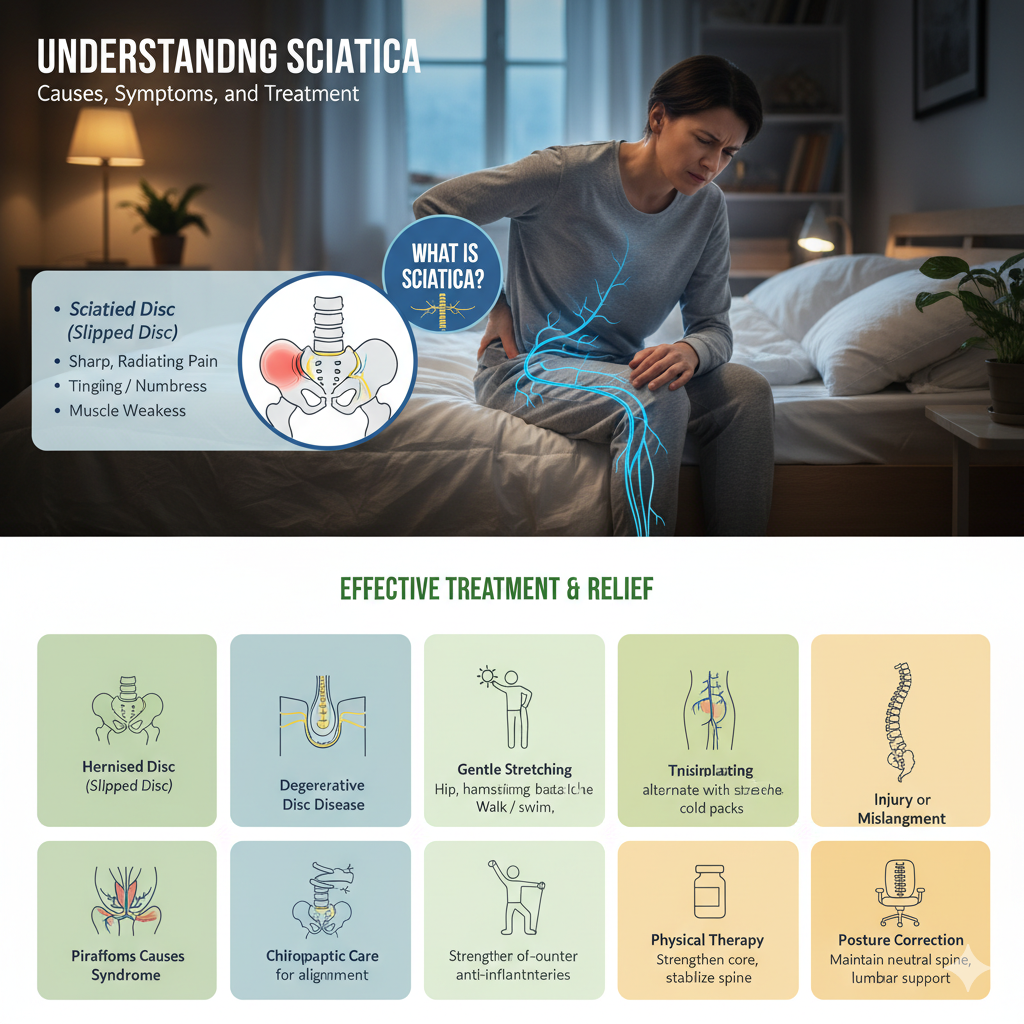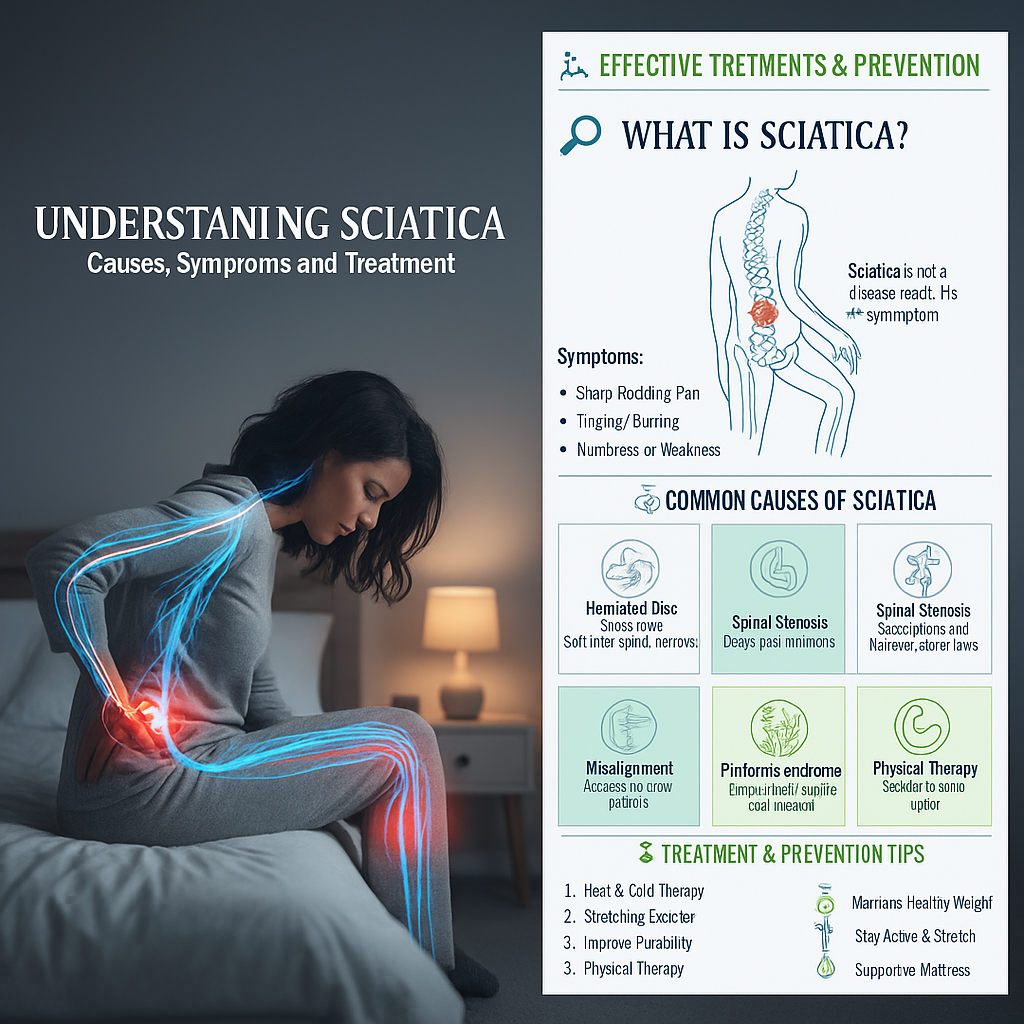If you’ve ever felt a sharp, shooting pain that travels from your lower back down to your leg, you may be experiencing sciatica. This common condition affects millions of people worldwide and is one of the main reasons for back pain when lying down or sitting for too long. Understanding what sciatica is, what causes it, and how it can be treated is key to finding lasting relief and improving your sleep and quality of life.
What Is Sciatica?
Sciatica isn’t a disease itself it’s a symptom of an underlying issue affecting the sciatic nerve, the largest nerve in the human body.
This nerve runs from your lower spine, through your hips and buttocks, and down both legs.
When something compresses or irritates this nerve, you may feel:
- Sharp, radiating pain down one leg
- Tingling or burning sensations
- Numbness or weakness in the leg or foot
These symptoms often occur on one side of the body and can range from mild discomfort to severe pain that interferes with daily activities and sleep.
Common Causes of Sciatica
Several conditions can lead to sciatic nerve irritation or compression. The most common include:
- Herniated Disc (Slipped Disc)
The soft inner material of a spinal disc can bulge out and press on the sciatic nerve.
This is the most frequent cause of sciatica in adults aged 30–50. - Degenerative Disc Disease
As we age, the spinal discs naturally wear down, losing their cushioning ability.
This can cause inflammation and direct pressure on the nerve roots. - Spinal Stenosis
Narrowing of the spinal canal can pinch the sciatic nerve, leading to pain that worsens while standing or walking. - Piriformis Syndrome
The piriformis muscle, located deep in the buttock, can spasm and irritate the sciatic nerve.
This often mimics traditional sciatica symptoms. - Injury or Misalignment
Accidents, poor posture, or spinal misalignment can also cause nerve compression and inflammation.
Sciatica and Back Pain at Night
Many people with sciatica find that pain gets worse when lying down. This happens because certain sleep positions can increase pressure on the sciatic nerve or the lower spine.
If you experience back pain at night, consider adjusting your sleep posture:
- Sleep on your side with a pillow between your knees to reduce strain on your spine.
- Avoid sleeping on your stomach, as it twists the lower back and worsens nerve compression.
- If you lie on your back, place a small pillow under your knees for support.
Learn more in our guide on Back Pain When Lying Down: Causes, Relief, and Better Sleep
Symptoms to Watch For
Sciatica can vary from mild to severe, but common symptoms include:
- Pain radiating from the lower back to one leg
- Tingling, burning, or numbness in the leg or foot
- Weakness when standing or walking
- Pain that worsens after sitting for long periods
- Discomfort that disrupts sleep or rest
If these symptoms persist for more than a week, worsen at night, or cause difficulty walking, it’s time to consult a healthcare provider or chiropractor.

Effective Treatments for Sciatica
Most people recover from sciatica with conservative treatment, without surgery. The key is to reduce inflammation, ease pressure on the nerve, and strengthen surrounding muscles.
1. Heat and Cold Therapy
- Apply a heating pad to relax tense muscles and improve blood flow.
- Alternate with cold packs to reduce inflammation.
(See our full guide on how to use a heating pad safely for more detail.)
2. Gentle Stretching and Exercise
- Focus on hip, hamstring, and lower back stretches to relieve tension.
- Regular walking or swimming can also reduce pressure on the sciatic nerve.
3. Chiropractic Care
- A chiropractor can perform spinal adjustments to improve alignment and relieve nerve compression.
- Chiropractic care often helps reduce both pain intensity and recurrence.
4. Physical Therapy
- Targeted exercises strengthen the core and stabilize the lower spine.
- Therapists may also use ultrasound or electrical stimulation for pain relief.
5. Medication
- Over-the-counter anti-inflammatories (like ibuprofen) can ease pain temporarily.
- Always consult your doctor before starting long-term use.
6. Posture Correction
- Maintaining a neutral spine while sitting or standing can prevent flare-ups.
- Ergonomic chairs and proper lumbar support can make a big difference.
When to Seek Medical Help
You should contact a healthcare professional if:
- The pain lasts longer than 10 days.
- You experience numbness or weakness in the leg.
- You lose bladder or bowel control.
- The pain becomes unbearable at night.
These may indicate a more serious issue requiring immediate care.
Prevention Tips
- Maintain a healthy weight to reduce strain on your spine.
- Stay active and stretch daily.
- Avoid prolonged sitting; take movement breaks.
- Use proper lifting techniques (bend your knees, not your back).
- Sleep on a supportive mattress and pillow designed for spinal alignment.
Final Thoughts
Sciatica can be painful, but it’s also manageable. By understanding its causes, recognizing symptoms early, and following the right combination of self-care and professional guidance, you can reduce pain, sleep better, and restore your daily comfort.
If your sciatica flares up at night or while resting, it’s often connected to your sleep posture and spinal alignment two factors closely linked with back pain when lying down.
Start by making small changes, stay consistent, and seek professional help if symptoms persist. Relief is possible with the right approach.


